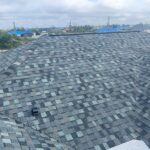Faqs About A New Roof
If it’s time to replace your roof, we’ve got all the information you need to make an informed decision.
1. How much will a new roof cost?
How much will a new roof cost?
This is the first question that comes to mind when you think about replacing your roof. If you’re not sure what type of roofing material would work best for your home, here are some things to consider:
Is it an older home or newer? Older homes often have more complicated roofs that require extensive repairs and maintenance. Newer homes may have simpler designs that require less work overall (and therefore cost less).
What kind of features do I want in my roof? Some people prefer metal roofs because it lasts longer than asphalt shingles and doesn’t’ require painting or staining every few years like wood does; others prefer slate because it looks beautiful on historic houses but doesn’t last as long as other materials like asphalt shingles which can last up to 30 years without needing replacement even though they’re more expensive upfront than most other types of materials used today by contractors throughout Florida today!
2. How many roofing options do I have?
You have a lot of options when it comes to your new roof. You can choose asphalt shingles, metal roofs, or even tile roofs if you want something more traditional and ornate. Depending on what kind of home you live in and how much money is available for this project, there are many different types of materials available at different price points that could work well for you:
Asphalt shingles are one of the most common types of roofing materials used today–and they’re often used on homes with low budgets because they’re inexpensive and easy to install. However, they’re not without their drawbacks; while asphalt does last a long time compared to other types of materials (20-30 years), it does tend to crack over time due to changes in temperature or humidity levels within your house’s environment.”
3. How long will it take to install my new roof?
If you want to know how long it will take to install your new roof, the answer is: it depends. It could be done in one day, but it’s more likely that it will take several days or even weeks. The longer time frame is usually due to scheduling issues and inclement weather–not because of any problems with your contractor or his crew.
The average time for installing a full replacement roof on an average house is about two days per 1000 square feet of surface area (or 1/10th acre), which translates into about 4-6 hours per 100 square feet if you’re doing all the work yourself with hand tools like hammers and saws instead of power tools like nail guns or compressors that require electricity from outside sources such as generators or extension cords plugged into outlets located within 50 feet away from where they were used during construction activities such as installing siding panels onto exterior walls while standing up high off ground level surfaces such as ladders; scaffolding platforms; walkways built out over empty space between floors inside buildings so workers don’t fall down stairs when going up staircases built into them etc., especially if there aren’t any railings along these paths leading back down again – which means we recommend hiring professionals who know what they’re doing if possible since accidents do happen sometimes when people try things themselves without proper training beforehand.”
4. Should I replace the sheathing or decking?
Sheathing is the layer of plywood or OSB that covers your roof rafters. It’s what keeps the water out and provides added insulation, so it’s important to make sure your sheathing is in good shape before you decide on a new roofing system.
Decking is simply another word for flashing–the metal or plastic pieces that go over your valleys (the spaces between two adjacent slopes) when installing shingles. Flashing helps keep moisture from leaking through these areas by covering them with something watertight; some types of decking are more effective than others at preventing leaks, so you’ll want to consider this as well when choosing shingle systems!
.
5. Should I install a new ridge vent or add more ventilation?
If you’re looking to add more ventilation to your roof, consider installing a ridge vent. Ridge vents are installed at the peak of a roof and allow hot air to escape through them, preventing moisture buildup and ice dams in colder climates.
If you want to install a new ridge vent but aren’t sure how, we can help! We’ll walk you through all the steps involved with installing one so that it looks great when we’re done.
6. Do I need drip edge and flashing?
If you have a new roof, you will need drip edge and flashing. Drip edge is installed along the roof’s edge, while flashing is installed around chimneys, vents and skylights. Both are sold in rolls with instructions on how to install them.
7. Can I use solar panels on a new roof?
You can install solar panels on a new roof, but it depends on the size of your home and how much power you want to generate. The more sun you get in your area, the better. You’ll also need to factor in other factors like how much shade there is around your property and what kind of materials are used in construction–the darker they are, the less light they let through.
If you’re looking to make renewable energy investments as part of an overall plan for sustainability, then solar panels may be right for you. They’re an investment that will pay off over time: over 20 years from now (which is when most homeowners’ mortgages are paid off), those same solar panels could save up to $5 per month on electricity bills! Plus this investment comes with another perk: it’s also tax deductible!
8. Why do I need new underlayment (roofing felt)?
Underlayment is the layer of material that sits directly on the rafters, and it’s what helps keep your roof from leaking. It prevents leaks by stopping ice dams, preventing water from seeping through the roof, and protecting the roofing materials. If you have an older home with asphalt shingles (as most older homes do), then you probably need to replace all of your old felt before installing new shingles.
If you’re thinking about getting a new underlayment installed along with new shingles in order to prevent any future problems with leaks or other issues related to aging underlayment materials: don’t worry! We’ll take care of everything for you so that everything goes smoothly without any headaches on your end or ours!
A new roof is one of the biggest renovations you can make to your home, but it’s also something that can improve your energy efficiency, reduce your utility bills and enhance the appearance of your home for decades to come. It’s important to answer all of your questions before you think about purchasing a new roof, so here are eight common questions homeowners ask when they’re considering putting a new roof on their home.
A new roof is one of the biggest renovations you can make to your home, but it’s also something that can improve your energy efficiency, reduce your utility bills and enhance the appearance of your home for decades to come. It’s important to answer all of your questions before you think about purchasing a new roof, so here are eight common questions homeowners ask when they’re considering putting a new roof on their home.
How long will my new roof last?
How much does it cost? 3. What type of materials should I use in my area? (e.g., metal roofs vs asphalt shingles)
. Is there anything else I need to consider before choosing between these two options?
We hope these FAQs were helpful and answered some of your questions. If you have more questions or would like to schedule an in-home consultation, please contact us today!


